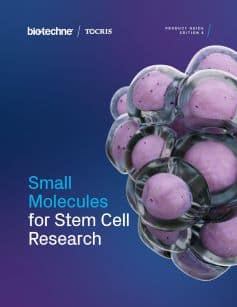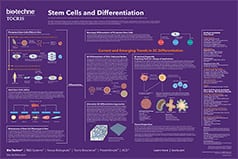ESCs and iPSCs
Embryonic stem cells (ESCs) are found in the inner cell mass of blastocysts. They are considered immortal as they have an unlimited capacity for self-renewal in an undifferentiated state. Like ESCs, induced pluripotent stem cells (also known as iPS cells or iPSCs) are also pluripotent stem cells that can be generated directly from adult cells, they can propagate indefinitely. View all pluripotent stem cell resources available from Bio-Techne.
| Cat. No. | Product Name / Activity |
|---|---|
| 4845 | A 939572 |
| Induces cell death of undifferentiated human ESCs; SCD1 inhibitor | |
| 1140 | 8-Bromo-cAMP, sodium salt |
| Promotes differentiation of human iPS cell-derived intestinal epithelial cells; cell-permeable cAMP analog | |
| 5687 | Centrinone |
| Selective PLK4 inhibitor; induces differentiation in PSCs | |
| 5329 | CKI 7 dihydrochloride |
| CK1 inhibitor; induces retinal cell differentiation from human ESCs and iPSCs | |
| 1623 | Cyclopamine |
| Inhibitor of Hedgehog (Hh) signaling; induces differentiation of hESCs into hormone expressing endocrine cells | |
| 6873 | DC 271 |
| Fluorescent retinoic acid analog; solvochromatic probe | |
| 1141 | Dibutyryl-cAMP, sodium salt |
| Promotes differentiation of hPSCs to dopaminergic neurons; cell-permeable cAMP analog | |
| 4126 | DMH-1 |
| BMP receptor ALK2 inhibitor; promotes iPSC neurogenesis in combination with SB 431542 (Cat. No. 1614) | |
| 3176 | DMSO, sterile filtered |
| Improves responsiveness of hESCs and hiPSCs to differentiation signals | |
| 3093 | Dorsomorphin dihydrochloride |
| BMP type I receptor inhibitor; promotes cardiomyocyte differentiation in mouse ESCs | |
| 1041 | 1-EBIO |
| KCa activator; promotes ESC differentiation into cardiomyocytes | |
| 4011 | EC 23 |
| Synthetic retinoid; induces neural differentiation of hESCs | |
| 6790 | GSK 126 |
| Promotes the transition of ESCs to feeder-free extended pluripotent stem (EPS) cells | |
| 4650 | I-BET 151 dihydrochloride |
| BET bromodomain inhibitor; also promotes differentiation of hiPSCs into megakaryocytes | |
| 4015 | IDE 1 |
| Induces definitive endoderm formation in mouse and human ESCs | |
| 5068 | ITD 1 |
| Selective inhibitor of TGF-β signaling; induces cardiomyocyte differentiation in ESCs | |
| 5214 | IWP 4 |
| Potent inhibitor of Wnt/β-catenin signaling; induces cardiomyocyte differentiation of human ESCs and iPSCs | |
| 4731 | KY 02111 |
| Inhibits canonical Wnt signaling. Promotes differentiation of human ESCs and iPSCs into cardiomyocytes | |
| 7419 | Kyoto Probe-1 |
| Fluorescent probe that selectively identifies undifferentiated iPS/ES cells | |
| 6053 | LDN 193189 dihydrochloride |
| Potent and selective ALK2 and ALK3 inhibitor; promotes neural induction of hPSCs | |
| 8150 | LDN 193189 in solution |
| Sterile-filtered 10 mM solution of LDN 193189 pre-dissolved in water | |
| 6068 | Lin28 1632 |
| RNA binding protein Lin28 inhibitor; promotes mESC differentiation | |
| 7874 | N-Acetylcysteine |
| Component of culture media for ESCs generated embryos; also GSH precursor and antioxidant | |
| 2694 | PD 407824 |
| Sensitizes hESCs to BMP4 to induce differentiation; also potent and selective inhibitor of Chk1 and Wee1 | |
| 4847 | PluriSln 1 |
| Inhibitor of SCD1; selectively eliminates undifferentiated hPSCs from culture | |
| 6577 | Pyridone 6 |
| Induces intermediate mesoderm; cell permeable JAK inhibitor | |
| 1292 | Rapamycin |
| mTOR inhibitor; also drives hPSC differentiation to mesendoderm and blood progenitor cells | |
| 4366 | SAG |
| Enhances neuronal differentiation of iPSCs into dopaminergic neurons; Smo agonist | |
| 6881 | SB 4 |
| Potent BMP4 agonist; activates canonical BMP signaling | |
| 6424 | Sodium Cromoglicate |
| Promotes ESCs/iPSCs differentiation into pancreatic endocrine islet cells | |
| 4484 | STF 31 |
| Eliminates undifferentiated hPSCs from culture; also NAMPT and GLUT1 inhibitor | |
| 7405 | TWS 119 |
| Induces neuronal differentiation in ESCs; potent GSK3 inhibitor | |
| 5148 | Wnt-C59 |
| Wnt signaling inhibitor; induces differentiation of iPSCs to cardiomyocytes |
Embryonic stem cells (ESCs) are found in the inner cell mass of blastocysts. They are considered immortal as they have an unlimited capacity for self-renewal in an undifferentiated state. ESCs have the ability to differentiate into cells from all three germ layers (endoderm, mesoderm and ectoderm).
Embryonic stem cells (ESCs) are pluripotent cells and differentiation is tightly controlled by growth factor, cytokines and epigenetic processes such as DNA methylation and chromatin remodeling. ESCs divide into two cells: they can either differentiated in to two identical daughter cells, or one undergoes self-renewal and produces an identical stem cell, and the other cell be will differentiated.
Induced pluripotent stem cells (also known as iPS cells or iPSCs) can be generated directly from adult cells. Like ESCs, they can propagate indefinitely. Given the right cocktail of factors and or small molecules, they can be reprogrammed to differentiate into many types of somatic cells, including neurons, cardiomyocytes, and hepatocytes. Stem cell therapies using these types of cells are now entering the clinic.
ESCs and iPSCs have great potential for use in regenerative medicine to repair damaged tissue, and in organ transplantation to generate human organ tissues. The use of iPSCs in medicine has the advantage that the cells are autologous, limiting the risk of immune rejection.
Stem cells offer the potential for treating many diseases including cancer and neurodegenerative conditions, such as Alzheimer's, Parkinson's or Huntington's diseases, or repairing damaged tissue from myocardial infarction.
Literature for ESCs and iPSCs
Tocris offers the following scientific literature for ESCs and iPSCs to showcase our products. We invite you to request* your copy today!
*Please note that Tocris will only send literature to established scientific business / institute addresses.
Stem Cells Scientific Review
Written by Kirsty E. Clarke, Victoria B. Christie, Andy Whiting and Stefan A. Przyborski, this review provides an overview of the use of small molecules in the control of stem cell growth and differentiation. Key signaling pathways are highlighted, and the regulation of ES cell self-renewal and somatic cell reprogramming is discussed. Compounds available from Tocris are listed.
Stem Cell Workflow Poster
Stem cells have potential as a source of cells and tissues for research and treatment of disease. This poster summarizes some key protocols demonstrating the use of small molecules across the stem cell workflow, from reprogramming, through self-renewal, storage and differentiation to verification. Advantages of using small molecules are also highlighted.



